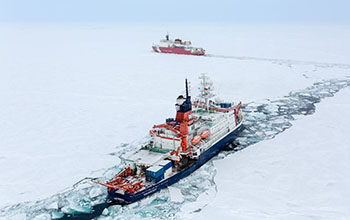搜索结果: 1-13 共查到“海洋科学 make rivers”相关记录13条 . 查询时间(0.031 秒)

Sea level rise could make rivers more likely to jump course(图)
Sea level rise make rivers likely jump course
2020/8/21
Sea level rise is poised to shift the way rivers naturally chart their paths to the shoreline. The nature of that change will depend on both the rate of rise and the sediment load carried by the river...

Freshwater runoff from rivers brings more carbon, nutrients to Arctic Ocean(图)
Freshwater runoff rivers carbon nutrients Arctic Ocean
2020/4/17
A new study by National Science Foundation-funded researchers at the Woods Hole Oceanographic Institution and their colleagues found that freshwater runoff from rivers and continental s...
Humans concerned about climate change are working to find ways of capturing excess carbon dioxide (CO2) from the atmosphere and sequestering it in the Earth. But Nature has its own methods for the rem...
Phytoplankton growth in three rivers: The role of meroplankton and the benthic retention hypothesis
Phytoplankton growth three rivers The role of meroplankton the benthic retention hypothesis
2014/4/8
We analyzed long-term (5–8 yr) hourly time series of chlorophyll (Chl) converted from fluorescence measurements in relation to discharge and light in three medium- to large-size rivers, where plankton...
Many natural streams are net heterotrophic, so I propose that trophic state be divided into autotrophic and
heterotrophic state. This division allows consideration of the influence of external ...
We investigated physical, chemical, and biological variables contributing to biochemical oxygen demand (BOD)
in 17 North Carolina lotic and lentic water bodies affected by mild to severe hypoxia. Phy...
Synchrony and seasonality in bacterioplankton communities of two temperate rivers
bacterioplankton communities Synchrony seasonality
2014/5/13
The bacterioplankton community composition (measured with denaturing gradient gel electrophoresis of 16S
ribosomal DNA [rDNA]) of two nonintersecting temperate rivers was nearly identical and changed...
Nutrient variations in boreal and subarctic Swedish rivers: Landscape control of land– sea fluxes
boreal and subarctic Swedish land– sea fl uxes
2014/5/19
We examined the hypothesis that the extent of vegetation cover governs the fluxes of nutrients from boreal and
subarctic river catchments to the sea. Fluxes of total organic carbon (TOC) and di...
Role of wetlands and developed land use on dissolved organic nitrogen concentrations and DON/TDN in northeastern U.S. rivers and streams
Role of wetlands developed land dissolved organic nitrogen concentrations DON/TDN northeastern U.S. rivers and streams
2014/5/19
Previous studies have shown that watersheds with significant human development (i.e., urban and agricultural land use) generally have higher concentrations and fluxes of dissolved inorganic nitrogen (...
Periphyton density influences organochlorine accumulation in rivers
Periphyton density organochlorine accumulation rivers
2014/5/22
To investigate the influence of eutrophication on organochlorine dynamics in lotic systems, we related polychlorinated biphenyl (PCB) concentrations in brown trout (Salmo trutta) to the periphyton den...
Bottom-up controls on bacterial production in tropical lowland rivers
bacterial production tropical lowland rivers
2014/5/21
The importance of organic carbon and inorganic nutrients in controlling bacterial production was investigated in
two tropical lowland rivers draining undisturbed forested catchments. Glucose (C), amm...
Spatio-temporal geochemistry of mercury in waters of the Tapajo′s and Amazon rivers, Brazil
he Tapajo′s Amazon rivers
2014/6/9
Spatial and temporal variations of mercury (Hg) concentrations were monitored in the surface waters from the
lower portion of the Tapajo′s River, the Arapiuns River, its principal tributary, and the ...
Role of colloids and fine particles in the transport of metals in rivers draining carbonate and silicate terrains
Role of colloids fi ne particles
2014/5/30
We have used cross flow filtration (CFF) to determine the pools of fine particulate (0.1–0.45 mm), colloidal (1,000
Dalton to 0.1 mm), and dissolved (,1,000 Dalton) metals in seven ...

